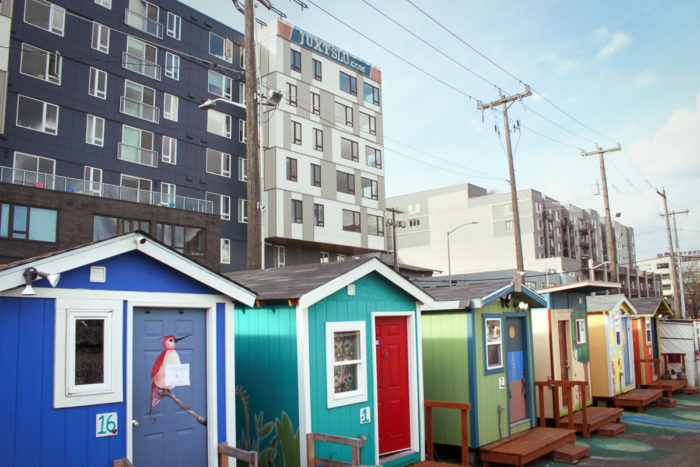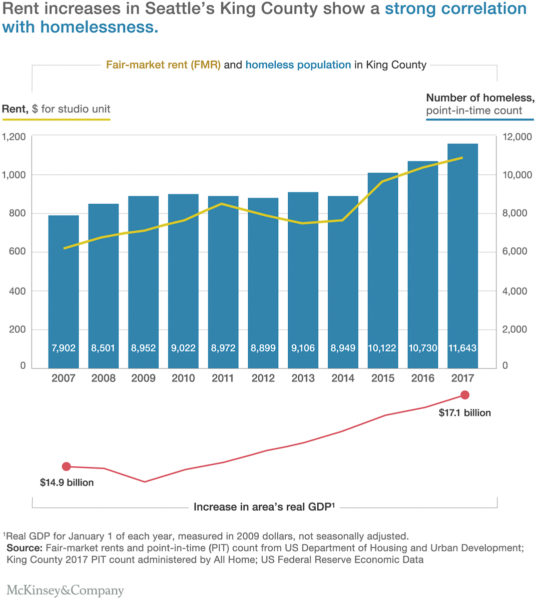
“Alexa, lock the door and start the robot vacuum.”
In Black Diamond, about an hour southeast of Seattle, Amazon recently launched a smart home, where AI Alexa helps with household chores from A to Z. Lennar Homes, the developer, partnered with Amazon to build several houses in the neighborhood filled with smart home technologies, where Alexa controls almost everything in the house.
While Amazon is busy designing the homes of tomorrow, more and more Seattle residents are struggling to pay the rent today.
Finding affordable housing has become a lot harder since the boom of Amazon and other tech companies. Rents in the Greater Seattle area have soared 69 percent over the past ten years, and homelessness has risen by 9% each year since 2014.
Although Seattle is one of the cities with the highest minimum wage in the country — $16 for large employers and $15 for all other employers— finding affordable housing is still challenging to renters, especially to minimum-wage workers in the city.
Nearly half of Seattle-area rent households are struggling paying rents, with around 53,000 renters in the area paying more than half of their income to their landlords.
Affordable housing is well out of reach
A showroom designer for a retail store in Bellevue, Rachael Scott makes $15 per hour. She says she pays about a third of her income toward rent every month — even as she’s sharing the costs with her partner, who is an assistant manager at Verizon.
Ever since she moved to Seattle from Mississippi a few years ago, Scott has been enjoying hiking in the mountains and exploring good coffee places in the area. But at the same time, she’s struggled with the high cost of living here.
“My rent is nearly $1700, and the only jobs I can get are $15 an hour,” she said “Either rent needs to come down, or minimum wage needs to go up to $25 an hour.”
After looking far and wide for an apartment that she could afford, she decided to bite the bullet and commute from Bothell to Bellevue every morning.
“I would love to see more affordable housing that isn’t a third of income before taxes, so low-income earners can save up for life emergencies instead of staying stuck in the paycheck to paycheck cycle,” she said.
Tech companies and government chip in millions
Some experts point to the presence of giant tech companies like Amazon and Microsoft in the city as a cause of a rental rise. For all the high paying jobs they’ve created, the corresponding cost of living increases have priced out people who don’t work in that sector.
A 2018 study from the Hanley Wood Data Studio that analyzed Amazon’s impact on rents summarized the issue:
“Because rental values have risen so significantly, many older, less desirable apartment buildings that would be considered affordable have been bought, refurbished, and put back on the market at a much higher rental rate due to the lack of inventory.”
Making things worse, developers complain that the intended consumer protections of the Washington Condo Act have backfired, by driving up the costs of building apartments that are to be sold. This leaves residents stuck with two unaffordable options: million-dollar single-family homes or high-end rentals.
For many housing advocates, it all leads back to big tech.
“Amazon and Microsoft have the largest employers in the region, so they are responsible for huge immigration of new people moving to Seattle looking for housing,” said Sharon Lee, executive director of the Low-Income Housing Institute (LIHI) in Seattle.

To counter the complaints, the city, and some tech companies, are now pushing their own solutions for the housing crisis.
In December, Seattle Mayor Jenny Durkan announced that the city would invest $110 million for construction of affordable housing, including 11 buildings for low-income families and individuals and 304 dwellings for chronically homeless people.
Aiming to open this year, Amazon is building a homeless shelter in its headquarters in downtown Seattle, which will be “the largest family shelter in Washington state.” It will also offer occupants several programs for rehabilitation, such as coding classes and resume help by Amazon employees.
Microsoft is chipping in $500 million to fund affordable housing and homeless services in the city. As a part of the project and with the partnership with King County, the company provided a $60 million, 15-year loan at below-market interest rates to the King County Housing Authority “to combat the Puget Sound affordable housing crisis.”
“Barely making a dent”
In spite of such efforts by the city and big tech, the affordable housing crisis isn’t going away.
Lee sees those tech giant and city projects as, in her words, “insufficient to address the magnitude of the problem.”
While she sees the new Amazon shelter as a positive step, Lee believes that it is just a small dent. She said they should be offering solutions on a much larger scale, as what people really need is permanent affordable housing, not just a temporary family shelter.
“There ought to be shared responsibilities among the corporate sector and business community,” she said. “We should have capital resources, service resources, and operate the subsidies for not just families with children, but also homeless individuals, couples, seniors, people with disabilities.”
Even some tech workers say raising funds to mitigate the current situation isn’t enough, and must be paired with adequate public policy for the long term.
“While all those efforts are nice, they’re just scratching the surface if we don’t fix the policy environment in the broader, public investment side of things,” said Ethan Phelps-Goodman, a former Facebook software engineer and a founder of Tech 4 Housing, an advocacy group that’s organizing tech workers to speak up for housing crisis and policy changes,
Instead of a productive approach to housing, he emphasizes that the housing affordability crisis and homelessness can be fixed by changing the public policies regarding land use and investment in affordable housing.
“We want to keep Seattle diverse, and we think having mixed-income communities is important,” Lee said. “But we are losing ground with gentrification and displacement, and Seattle is becoming less diverse because people are squeezed out.”
For Rachael Scott, the dream of buying a condo or townhouse in Seattle is still out of reach. She’s hustling to try to get a new high-income job as the first step.
“I came here to find more opportunities from Mississippi,” she said. “I’ve been applying to jobs, taking tests and interviewing and reworking my resume when I get off work. I need to land a really good job so I can afford to live here.”
This story was produced as part of The Seattle Globalist’s Fall 2019 Tech and Social Justice Fellowship, in partnership with the University of Washington’s Communication Leadership master’s program.



If the focus on condo could go in the direction of detached structures such as ADU as backyard cottages on the same tax parcel that could be sold independently as a stand-alone condo dwelling the exposure to shared walls, roof, floors and the like completely go away allowing more builders the ability to build these units.
ADU reform needs to be addressed allowing for a detached single-family dwelling unit that has the same regulations regarding a single-family structure with no lot size limitations, reduced impact, permitting and plan review fees if the new proposed structure is a single-story dwelling, off-street parking bonus, no owner-occupancy requirements, across the State. Doing so you would see new smaller size infill construction suitable for a variety of households and incomes, from aging parents to our young adults starting out.